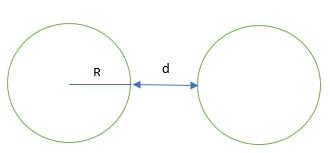
Two identical spheres of radius R made of the same material are kept at a distance d apart. Then the gravitational attraction between them is proportional to:
$$A. d^{-2}$$
$$B. d^2$$
$$C. d^4$$
$$D. d$$
$$E. d^{-4}$$
Answer
588k+ views
Hint: Here, we need to know about Newton's gravitational law.
It is the law of attraction between two masses. From this law, we can know the relationship between attraction force and distance between two masses.
Formula used: $$F=G\dfrac{m_1m_2}{d^2}$$
Complete step-by-step answer:
Newton’s law of gravitation states that the attraction between two objects is proportional to the product of their masses and inversely proportional to the square of their distance. Again this force acts along the line joining the two objects.

Actually this law was proposed for point masses, where it was easy to find the distance between two objects. The mathematical formula of the law is,
$$F=G\dfrac{m_1m_2}{d^2}$$
Where G is the universal gravitational constant, F is the gravitational force, d is the distance between the objects and $$m_1$$ , $$m_2$$ are the masses of the two objects.
In case of symmetrical objects, it is easy to find their distance. Luckily, here we have two identical spheres. Hence the distance can be measured from the centers of two spheres. However the distance is given to be d. So, the attraction force is proportional to $$\dfrac{1}{d^2}=d^{-2}$$
Hence, option A is the correct answer.
Additional information:
The value of the universal gravitational constant is $$G=6.674×10^{-11} Nm^2/kg^2$$ (in SI units).
Note: Apply Newton’s gravitational law when the objects are not charged. In case the objects are charged you have to use Coulomb’s law, which is almost similar.
$$F=\dfrac{1}{4π\epsilon_0}.\dfrac{q_1q_2}{d^2}$$
The q's are the charges. And $$\epsilon_0$$ is called the free space permittivity.
It is the law of attraction between two masses. From this law, we can know the relationship between attraction force and distance between two masses.
Formula used: $$F=G\dfrac{m_1m_2}{d^2}$$
Complete step-by-step answer:
Newton’s law of gravitation states that the attraction between two objects is proportional to the product of their masses and inversely proportional to the square of their distance. Again this force acts along the line joining the two objects.

Actually this law was proposed for point masses, where it was easy to find the distance between two objects. The mathematical formula of the law is,
$$F=G\dfrac{m_1m_2}{d^2}$$
Where G is the universal gravitational constant, F is the gravitational force, d is the distance between the objects and $$m_1$$ , $$m_2$$ are the masses of the two objects.
In case of symmetrical objects, it is easy to find their distance. Luckily, here we have two identical spheres. Hence the distance can be measured from the centers of two spheres. However the distance is given to be d. So, the attraction force is proportional to $$\dfrac{1}{d^2}=d^{-2}$$
Hence, option A is the correct answer.
Additional information:
The value of the universal gravitational constant is $$G=6.674×10^{-11} Nm^2/kg^2$$ (in SI units).
Note: Apply Newton’s gravitational law when the objects are not charged. In case the objects are charged you have to use Coulomb’s law, which is almost similar.
$$F=\dfrac{1}{4π\epsilon_0}.\dfrac{q_1q_2}{d^2}$$
The q's are the charges. And $$\epsilon_0$$ is called the free space permittivity.
Recently Updated Pages
Why are manures considered better than fertilizers class 11 biology CBSE

Find the coordinates of the midpoint of the line segment class 11 maths CBSE

Distinguish between static friction limiting friction class 11 physics CBSE

The Chairman of the constituent Assembly was A Jawaharlal class 11 social science CBSE

The first National Commission on Labour NCL submitted class 11 social science CBSE

Number of all subshell of n + l 7 is A 4 B 5 C 6 D class 11 chemistry CBSE

Trending doubts
What is meant by exothermic and endothermic reactions class 11 chemistry CBSE

10 examples of friction in our daily life

One Metric ton is equal to kg A 10000 B 1000 C 100 class 11 physics CBSE

1 Quintal is equal to a 110 kg b 10 kg c 100kg d 1000 class 11 physics CBSE

Difference Between Prokaryotic Cells and Eukaryotic Cells

What are Quantum numbers Explain the quantum number class 11 chemistry CBSE




